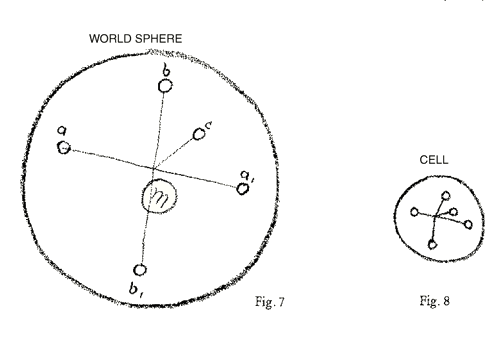
The Redemption of Astronomy:
Toward the Reunion of Natural Science and Social Science
Toward the Reunion of Natural Science and Social Science
Lecture 12 of 18.
Rudolf Steiner, Stuttgart, January 12, 1921:
My dear friends!
I will begin today by pointing out that our studies hitherto have led us to a specific result. We have drawn attention on the one hand to the movements of the heavenly bodies, and, though it still remains for us to do it in more detail, we have at least gained some conception: Here are a number of cosmic bodies in movement, in a certain order and configuration. Meanwhile we have also been drawing attention to the form of man, and incidentally, from time to time, to the forms of animal and plant-nature; this we shall have to do still more, to gain the necessary supports from diverse realms. In the main however, it is the human form and figure we have contemplated, and in so doing we have divined that the formation of man is in some way related to what finds expression in the movement of celestial bodies. We want to formulate it with great care.
Yesterday I showed that wheresoever we may look in the human body, we shall find the formative principle of the looped curve or Lemniscate, save for the two outermost polarities — the Radius and the Sphere. Thus in the human body we perceive three formative principles (Fig. 1): The Sphere, with its activity primarily going inward, the Radius, and between these the looped curve or Lemniscate. Truly to recognise these formative principles in the human organism, you must imagine the Lemniscate as such with variable constants, if I may use the paradox. Where a curve normally has constants in its equation, we must think variables. The variability is most in evidence in the middle portion of the human body. Take as a whole the structure of the pairs of ribs and the adjoining vertebrae. True as it is then that in the vertebra the one half of the Lemniscate is very much condensed and pressed together, whilst in the pair of ribs the other half is much extended and drawn apart (Fig. 2), we must not be put off my this. The underlying formative principle is the Lemniscate, none the less. We simply have to imagine that where the ribs are (the drawing indicated those that are joined in front via the sternum) the space is widened, matter being as it were extenuated, while, to make up for this, the matter is compressed and the space lessoned in the vertebra.
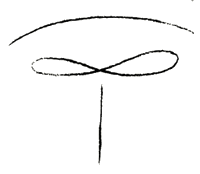
Figure 1
Let us now follow the human form and figure upward and downward from this middle portion. Upward we find the vertebra as it were bulged out into a wide cavity (Fig. 3), while the remaining branches of the Lemniscate seem to vanish, nestling away, so to speak, in the internal formative process, becoming hidden and undefined. Going downward from the middle portion, we contemplate for instance the attachment of the lower limbs to the pelvis. In all that opens downward from this point, we find the other half of the loop fading away. We have therefore to contemplate a fundamental loop-curve, mobile and variable in itself. This dominates the middle part of man. Only, the formative forces of it must be so imagined that in the one half (Fig. 2) the material forces become, as it were, more attenuated and the loop widens, while in the other it contracts.
Figure 2 | Figure 3 |
Further we must imagine that from this middle region upward the portion of the Lemniscate which in the vertebra was drawn together, bulges and widens out, while the other, downward-opening portion vanishes and eludes us. On the other hand, as you go downward from the middle part of man, the closed loop grows minute and fades away, while those portions of the curve which disappear as you go towards the head, run out into the radial principle and are here prolonged. (Fig. 4)
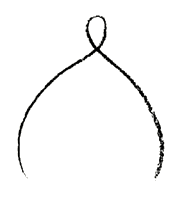
Figure 4
We should thus find our way into it, till we are able to see the only moving Lemniscate with perceptive insight. Also we think how the formative principle of the moving Lemniscate is combined with forces which are spheroidal on the one hand and on the other radial — radial with respect to the Earth's centre. We then have a system of forces which we may conceive as being fundamental to the form and figure, to the whole forming and configuration of the human body. (By the word “forces” I mean nothing hypothetical; — purely and simply what is made manifest in the forming of it.) Answering to this , in cosmic space, in the movement of celestial bodies, we also find a peculiar configuration, — configuration of movements. In yesterday's lecture, we recognised in the planetary loops the very same principle outside us which is the principle of form within us. Let us now follow this loop-forming principle in greater detail. Is it not interesting that Mercury and Venus make their loops when the planets are in inferior conjunction, i.e., when they are roughly between the Earth and the Sun? In other words, their loop occurs when what the Sun is for man — so to express it — is enhanced by Venus and Mercury. As against this, look for the loops of Mars, Jupiter and Saturn. These loops we find occurring when the planets are in opposition to the Sun. This contrast too, of oppositions and conjunctions, will in some way correspond to a contrast in the building forces of man. For Saturn, Jupiter and Mars, because their loops appear in opposition, the loops as loops will be most active and influential. Thinking along these lines, we shall indeed relate the loop-formation of Saturn, Jupiter and Mars to that in man which is little influenced by the Sun; for it takes place, once more, when the planet is in opposition. Whilst, inasmuch as Venus and Mercury form their loops when in conjunction, their loop-formation must in some way be related to what is brought about, amid the formative principles of man, by the Sun — or by what underlies the Sun. We shall therefore conceive the Sun's influence to be in some sense reinforced by Venus and Mercury, while it withdraws, as it were, in face of the superior planets, so-called. The latter, precisely during loop-formation, bring to expression something that bears directly, not indirectly, upon man.
If we pursue this line of thought and bear in mind that there is the contrast between Radius and Sphere, then we need but recall the form that comes to manifestation in these movements, and we shall say: In Mays, Jupiter and Saturn the essential phase must be when they are forming their loops, that is to say, when, in a manner speaking, the sphere-forming process comes into evidence. Mars, Jupiter and Saturn (not to speak of further planets) will show their influence upon that element in man which is assigned to the sphere-forming process, namely the human head. In contrast to this — they are indeed the polar opposite — the movements of Venus and Mercury will somehow find expression in what in man too is the opposite pole, opposite to the forming of the head, — i.e., what abandons parallelism with the spherical formation and becomes parallel to the radial. Where the one part of the Lemniscate becomes minute and the other grows into the limbs, into a purely radial development, we have to look for the relation to Venus and Mercury. This in turn will lead us on to say: In the superior planets, which make their loop when in opposition, it is the loop that matters; they develop their intensity while they form the loop. Whilst in the inferior planets Venus and Mercury — it is essential that they wield their influence by virtue of what is not the loop, — i.e., in contrast to the loop, by the remainder of the planet's path. Think of a Lemniscate like this (Fig. 5), say in the case of Venus (I draw it diagrammatically).
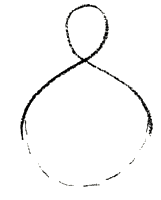
Figure 5
You will understand it if you imagine this part (dotted line) ever less in evidence, the farther you go downward. That is to say, whilst in the path of Venus it closes, in its effects it no longer does so, but, as it were, runs out into parabolic branches, answering precisely to what happens in the human limb, where the vertebra form fades away and loses character (to put it very briefly, omitting details). This loop of the Lemniscate is represented by the path's fading away, not being fully maintained; it only indicates the direction but cannot hold it. So, where it closes in the path of Venus in the Heavens, in man's formation it falls asunder. Thus, to sum up, the building principle of the human form, howsoever modified, is based on this; the metamorphosis emerges between head and limbs — the limbs with the metabolism which belongs to them — and in the great Universe this answers to the contrast between those planets that form them in opposition to the Sun. Between the two is then the Sun itself.
Now, my dear friends, something quite definite results from this Namely, we see that also with respect to the qualitative effects we have just referred to, we have to recognise in the Sun's path, even as to its form, something midway between what we find in the forms movement of the superior and of the inferior planets respectively. We must therefore assign, what finds expression in the path and movement of the Sun, to all that in man which is midway between the forming of the head and the metabolism, In other words, we must attribute to the rhythmic system some relation to the path of the Sun. We therefore have to imagine a certain contrast between the paths of the superior and of the inferior planets; and in the Sun's path a quality midway between the two.
There is now a very evident and significant fact, regarding both the Sun's path and the Moon's. Follow the movements of the two heavenly bodies; neither of them makes any loop. They have no loop. Somehow therefore we must contrast the relation to man, and to Earth nature generally, of Sun and Moon on the one hand and of the loop-forming planetary paths on the other. The planetary paths with their characteristic loops quite evidently correspond to what makes vortices and vertebrae, — to what is lemniscatory in man.
Look simply at the human form and figure and think of its relation to the Earth; we can do no other than connect what is radial in human form and stature with the path of the Sun, even as we connect what is lemniscatory in form with the typical planetary path.
You see then what emerges when we are able to relate to the starry Heavens the entire human being, not only the human organ of cognition. This in effect emerges: In the vertical axis of man we must in some way seek what answers to the Sun's path, whilst in all that is lemniscatory in arrangement we have to seek what answers to the planetary paths, — lemniscatory as they are too, though in a variable form. Important truths will follow from this, We must conceive, once more, that through his vertical axis man is related to the Sun's path. HOW then shall we think of the other path which also shows no loops, namely the Moon's? Quite naturally — you need only look with open mind at the corresponding forms on Earth — we shall be led to the line of which we spoke some days ago, the line that runs along the spine of the animal. There we must seek what answers to the Moon's path. And in this very fact — the correspondence of the human spinal axis to the Sun's path and of the animal spinal axis to the moon's _ we shall have to look for the essential morphological difference between man and animal.
Precisely therefore when we are wanting to discover what is essential in the difference of man and animal, we cannot stay on Earth. A mere comparative morphology will not avail us, for we must first assign what we there find to the entire Universe. Hence too we shall derive some indication of what must be the relative position of the Sun's path and the Moon's — shall we say, what is their mutual situation, to begin with, in perspective (for here again we must express it with great caution). They must be so situated that the one path is approximately perpendicular to the other.
The human vertical therefore — or, had we better say, what answers to the main line and direction of the spine in man — is related to the Sun's path. The rational morphology we are pursuing makes this coordination evident. Mindful of this, we must surely relate the Sun's path itself to what in some way coincides with the Earth's radius. Admittedly, the Earth may move in such a way that many of her radii in turn coincide with the Sun's path. The relation indicated will need defining more precisely in coming lectures. Yet this at least gives us a notion of it: the direction of the Sun's path must be radial in relation to the surface or the Earth. We have no other alternative. In no event can the Earth be revolving round the Sun. What has been calculated — quite properly and conscientiously, of course — to be the revolution of the Earth around the Sun must therefore be a resultant of some other kind of movements. To this conclusion we are driven.
The many relevant details as regards human form and growth are so very complicated that in this brief lecture-course not everything can be gone into. But if you really concentrate upon the morphological descriptions given (though they are only bare indications of a qualitative morphology), you will be able to read it in the human form itself: The Earth is following the Sun! The Sun speeds on ahead, the Earth comes after. This then must be the essence of the matter: the earthly and the solar orbit in some way coincide, and the Earth somehow follows the Sun, making it possible as the Earth rotates for the Earth's radii to fall into the solar path, or at the very least to be in a certain relation to it.
Now you may very naturally retort that all this is inconsistent with the accepted Astronomy. But it is not so, — it really isn't! As you are well aware, to explain all the phenomena, Astronomy today must have recourse not only to the primary notion of a stationary Sun supposed to be at the focus of an ellipse along which the Earth is moving — but to a further movement, a movement of the Sun itself towards a certain constellation. If you imagine the direction of this movement and other relevant factors, then from the several movements of Sun and Earth, you may well be able to deduce a resultant path for the Earth, no longer coincident with the ellipse in which the Earth is said to be going round the Sun, but of a different form which need not be at all like the supposed ellipse. All these things I am gradually leading up to; for the moment I only wish to point out that you need not think what I am telling you so very revolutionary as against orthodox Astronomy. Far more important is the method of our study, — to bring the human form and figure into the system of the starry movements. My purpose here is not to propound some astronomical revolution, nor is it called for. Look, for example: say this or something like it (Fig. 6) is the Earth's movement, and the Sun too is moving, You can well imagine, if the Earth is following the Sun in movement, it is not absolutely necessary for the Earth always to be running past the Sun tangentially. It may well be that the Sun has already gone along the same path and that the Earth always to be running past the Sun tangentially. It may well be that the Sun has already gone along the same path and that the Earth is following, Nay, it is possible, envisaging the hypothetical velocity that has been calculated for the Sun's proper movement, you may work out a very neat arithmetical result. Work out the resultant of the assumed Earth-movement and the assumed Sun-movement; you may well get a resultant movement compatible with present-day Astronomy, — velocity and all. Let me then emphasise once more: What I am here propounding is not unrelated to present-day Astronomy, nor do I mean it not be. Quite on the contrary, it is related to it more thoroughly and deeply than theories which are so frequently presented, nicely worked out in theoretic garb, selecting certain movements and omitting others. I am not therefore instigating an astronomical revolution in these lectures; let me say this again to prevent fairy-tales arising. What I intend is to co-ordinate the human form — inward and outward form, figure and formation — with the movements of the heavenly bodies, nay, with the very system of the Cosmos.
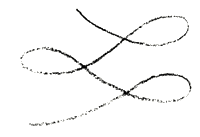
Figure 6
For the rest, may I call your attention to this: It is not so simple to bring together in thought our astronomical observations of the heavenly bodies and the accepted constructions of the orbits. For as you know from Kepler's Second Law, an essential feature, on which the forms of the orbits depend, are the radius-vectors, — their velocity above all. The whole form of the path depends on the functionality of the radius vectors. If this be so, does it not also reflect upon the forms of the paths which actually confront us? May it not be that we are cherishing illusions after all, at the mere outward aspect of them? It is quite possible: What we here calculate from the velocity and length of the radius vectors might not be primary magnitudes at all. They might themselves be only the resultants of the true primary magnitudes. If so, then the seeming picture which emerges must refer back to another and more deeply hidden.
This too is not so far afield as you might think. Suppose that in the sense of present-day Astronomy you wished to calculate the Sun's exact position at a given time of day and on a given date. Then it will not suffice you to take your start from the simple proposition, 'the Earth moves round the Sun'. People have thought it strange that in the ancient Astronomy (that of the Mysteries, not the exoteric version) they spoke of three Suns instead of one. So they distinguished three Suns. I must confess, I do not find it so very striking. Modern Astronomy too has its three Suns. There is the Sun whose path is calculated as the apparent counterpart of the Earth's movement round the Sun. This Sun occurs, does it not , in modern Astronomy? The path of it is calculated. Astronomy then has another Sun — an imagined one of course — with the help of which certain discrepancies are corrected. And then it has a third Sun, with the help of which it re-corrects discrepancies that persist after the first correction. Modern Astronomy too therefore distinguishes three: the real Sun and two imagined ones. It needs the three, for what is calculated to begin with does not accord with the Sun's actual position. It is always necessary to apply corrections. This alone should be enough to show you that we should not build too confidently on mere calculation. Other means are needed to arrive at adequate conceptions of the starry movements; others than the science of our time derives from sundry premises of calculation.
The broad ideas of planetary paths we have been laying out, it I may put it so, call now for great definition. Yet we shall only come to this if we contrive first to go further in out study of Earth-nature, to see their mutual relation in a certain aspect.
The Kingdoms of Nature are commonly thought of in a straight line: mineral kingdom, plant kingdom, animal kingdom, and I will add, human kingdom. (Some authorities would not admit the fourth, but that need not detain us.) The question now is: Is this arrangement sensible at all? Undoubtedly it is implicit in many of our modern lines of thought; at least it was so in the golden age of the mechanical outlook upon Nature. Today I know, in these wider realms of Science, there is a certain atmosphere of resignation, not to say despair. The habits of mind however remain the same as at their heyday, 20 or 30 years since. The scientists of that time would have been content, had they been able to follow up this series — mineral kingdom, plant kingdom, animal kingdom, man, — with the mineral kingdom as the amplest, deriving therefrom, by some combination of mineral structure, the structure of the plant, then by a further combination of plant structure the structure of the animal, and so on to man. The many thoughts that were pursued about the primal generation of living things, generatic aequivocs, — were they not eloquent of the tendency to derive animate living Nature from inanimate and at long last from inorganic or mineral? To this day, I believe, many scientiste would doubt if there is any other rational way of conceiving the inner connection in the succession of Nature's Kingdoms than by deriving them all ultimately from the Inorganic, even where they culminate in Man. You will find countless papers, books, lectures and so on, including highly specialised ones claiming to be strictly scientific, the authors of which — as though hypnotised — are always looking at it from this angle. How, they inquire, can it have happened, somewhere at some time in the course of Nature, that the first living creature came into being from some molecular distribution, i.e. from something purely mineral in the last resort?
The question now is, is it true at all to put the kingdoms of Nature in series in this way? Can it be done? Or, if we do, are we doing justice to their most evident and essential features? Compare a creature of the plant kingdom with an animal to begin with. Taking together all that you observe, you will not find in the forming of the animal anything that looks like a mere continuation or further elaboration of what is vegetable. If you begin with the simplest plant, the annual, you may well conceive its formative process to be carried further in the perennial. But you will certainly not be able to detect, in the organic principles of plant form and growth, anything that suggests further development towards the animal. On the contrary, you will more likely ascertain a polarity, a contrast between the two. You apprehend this polarity in the most evident phenomenon, namely the contrasting processes of assimilation: the altogether different relation of the plant and of the animal to carbon, and the characteristic use that is made of oxygen. I may remark, you must be careful here, to see and to describe it truly. You cannot simply say, the animal breathes-in oxygen while the plant breathes oxygen out and carbon in. It is not so simple as that. Nevertheless, the plant-forming process taken as a whole, in the organic life, reveals an evident polarity and contrast (as against the animal) in its relation to oxygen and carbon. The easiest way to put it is perhaps to say: What happens in the animal, in that the oxygen becomes bound to carbon and the carbonic acid is expelled, is for the animal itself and for man too. — an un-formative process, the very opposite of formative, a process which must be eliminated if the animal is to survive. And now the very thing which is undone in the animal, has to be done, has to be formed and builded in the plant. Think of what in the animal appears in some sense as a process of excretion, what the animal must get rid of makes for the forming and building process in the plant. It is a tangible polarity. You cannot possibly imagine the plant-forming process prolonged in a straight line, so as to derive therefrom the animal-formation. But you can well derive from the plant-forming process what has to be prevented in the animal. From the animal the carbon has to be taken away by the oxygen in the carbonic acid. Turn it precisely the other way round, and you will readily conceive the plant-forming process.
You therefore cannot get from plant to animal by going on in a straight line. On the other hand you can without false symbolism imagine here an ideal mean or middlepoint, on the one side of which you see the plant — and on the other the animal — forming process. It forks out from here (Fig. 7). What is midway between, — let us imagine it as some kind of ideal mean. If we now carry the plant forming process further in a straight line we arrive not at the animal but at the perennial plant. Imagine now the typical perennial. Carry the stream of development which leads to it still further; in some respects at least you will not fail to recognise in it the way that leads toward mineralisation. Here then you have the way to mineralisation, and we may justly say; In direct continuation of the plant forming process there lies the way that leads to mineralisation. Now look what answers to it at the contrasting pole, along the other branch (Fig. 7). To proceed by a mere outward scheme, one would be tempted to say: this branch too must be prolonged. There would be no true polarity in that. Rather should you think as follows: In the plant-forming process I prolong the line. In the animal-forming process I shall have to proceed negatively, I must go back, I must turn round; I must imagine the animal-forming process not to shoot out beyond itself but to remain behind — behind what it would otherwise become.
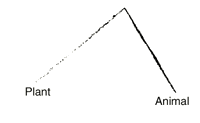
Figure 7
Observe now what is already available in scientific Zoology, in Selenka's researches for instance on the difference between man and animal in the forming of the embryo and in further development after birth, — comparing man and the higher animals. You will then have a more concrete idea of this "remaining behind". Indeed we owe our human form to the fact that in embryo-life we do not go as far as the animal but remain behind. Thus if we study the three kingdoms quite outwardly as they reveal themselves, without bringing in hypotheses, we find ourselves obliged to draw a strange mathematical line, that tends to vanish as we prolong it. This is what happens at the transition from animal to men, whilst on the other side we have a line that really lengthens (Fig. 8).
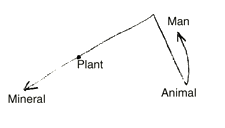
Figure 8
Here is a fresh extension of mathematics. You are led to recognise a distinction — a purely mathematical one — when you draw this diagram. Namely there are lines which when continued grow longer, and there are lines which when continued grow shorter. It is a fully valid mathematical idea. If then we want to set out the Kingdoms of Nature in a diagram at all, we must do it thus. First we must have some ideal point to start from. Thence it forks out: plant kingdom, animal kingdom on either hand. Thereafter we must prolong the two lines. Only, the plant-kingdom-line must be so prolonged that it grows longer; the animal-kingdom-line so that it grows shorter as we prolong it. I say again, this is a genuine, mathematical idea.
We thus arrive at real relationships between the Kingdom of Nature, though we begin by simply placing them side by side. The question now is — and we will only put it as a question, — What in reality corresponds to the ideal point in our diagram? We may divine that as the forming of the Kingdoms of Nature is related to this ideal point, so too must there be movements in the great Universe which relate to something somehow corresponding to it, — to this ideal mean. Let us reflect on it until tomorrow.
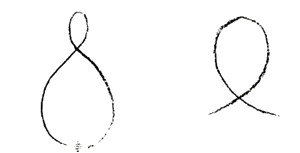



No comments:
Post a Comment